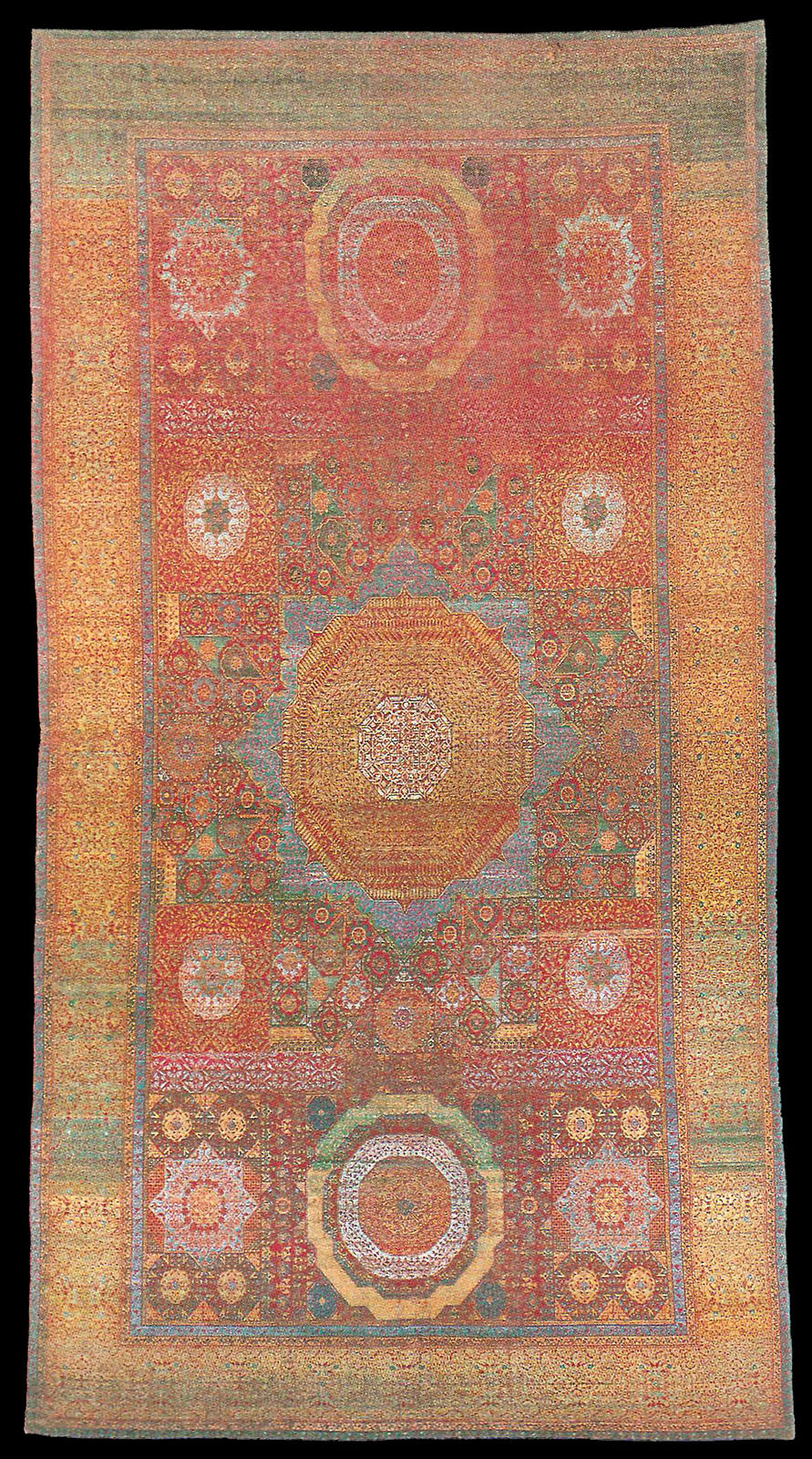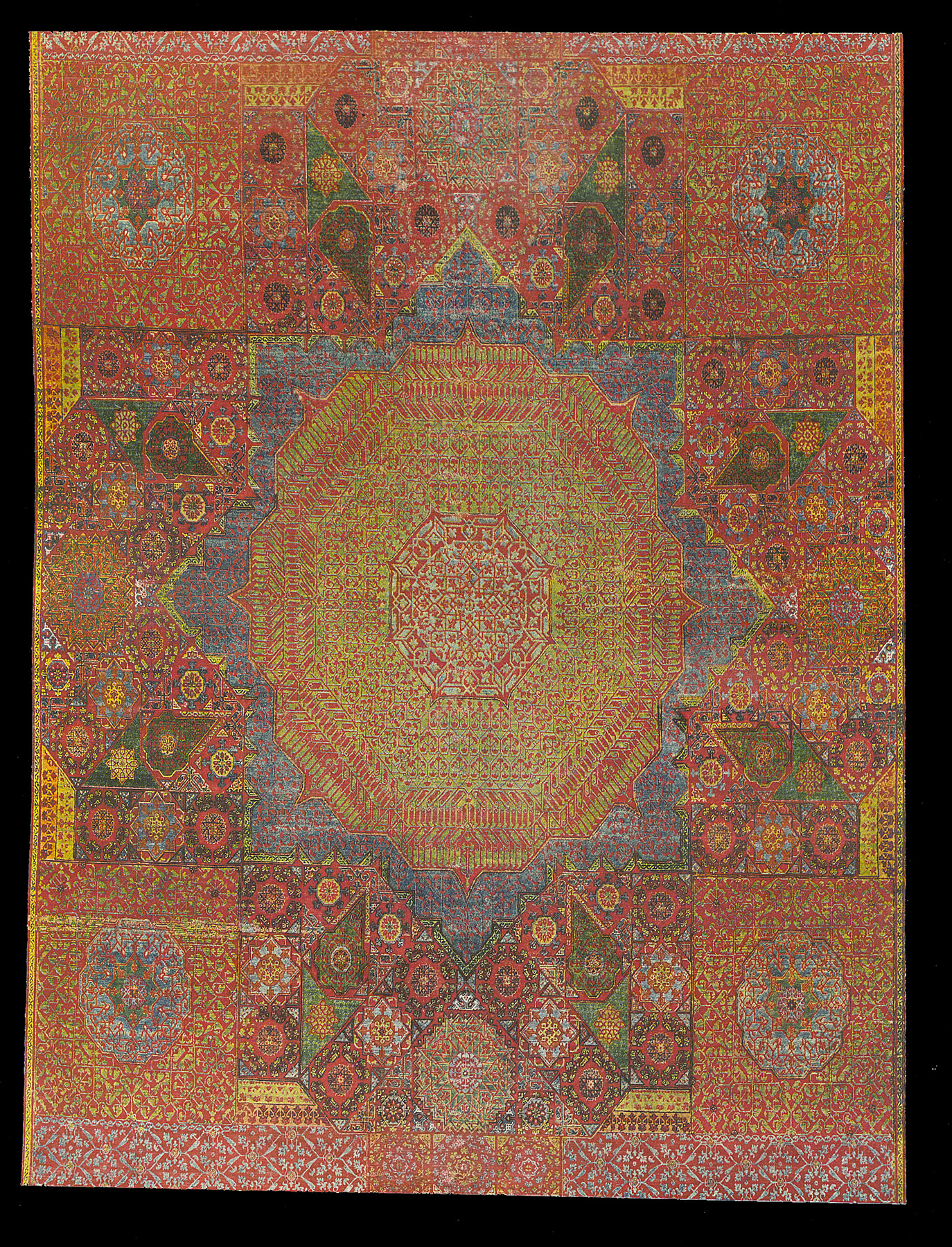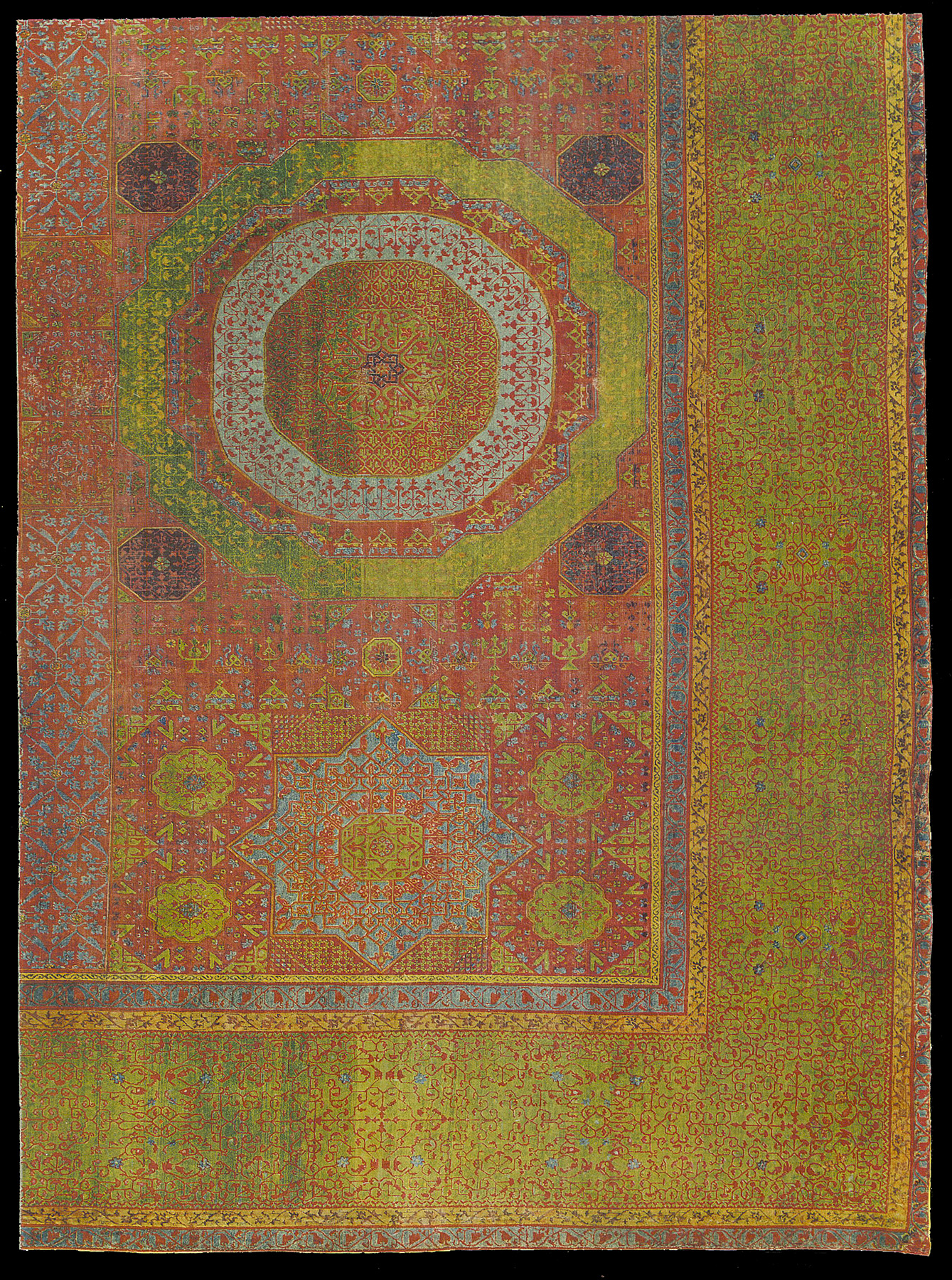|
Mamluk
medallion silk carpet, 16th century, Österreichisches Museum für angewandte Kunst,
Vienna, Austria.
inv no: T 8332, Size: 290x540cm.
This is the
only survivng example of a Mamluk carpet with a silk pile. Together with
an exceptionally varied palette, this creatres an unusual effect of
changing brightness, heightened by the kaleidoscopic effect - a result of
the very dense, mosaic-style design-that is typical of these carpets. The
three superimposed octagonal medallions are arranged on a field that is
completely filled with small, brightly colored geometric elements, such as
octagons, squares and rectangles, placed one next to the other and
repeated inside each other. Also unusual is the wide principal border
decorated with arabesques, which gives an eclectic touch to the whole.


|
|
(Formerly in the Imperial collection)
Length, 540 cm.j width, 290 cm.
Warp: yellow silk, some threads blue, two-fold. To 1 dm. 128 warp threads
(= 32 to the inch).
Weft: sheep's-wool, dyed red. After every row of
knots two shoots, each three-fold. The first shoot straight, the second
wavy.
The weft is full and wide.
Knotting: silk. To 1 dm. 49
knots in the length and 64 in the width (= 12 and 16 to the inch). Knotted
on two warp threads. Scheme III. To 1 square dm. about 5100 knots (= 192
to the inch). Pile to the left.
Colours: twelve. Ground-colours:
deep cherry-red (inner field), green (border), blue, light brown and light
yellow (edgings).
Colours of the pattern: green, light green, dark
green, blue, light blue, dark blue, deep blue, cherry-red, light brown,
yellow, black, white. The colouring of this carpet with its delicate sheen
is quite unusual, and renders it a particularly
important example of
carpet-weaving.
State Of preservation: relatively good. Part of the
inner field, towards one of the ends, very much worn, and repaired in
places. The black silk much decayed.
The inner field is closely
covered with symmetrically disposed geometrical ornamental ion and
conventional plant forms, repeating from right to left and from end to
end. The whole surface is divided into geometrical compartments (stars,
octagons, rosettes, triangles and rectangles). The pattern of the inner
field is adapted to its confines. The centre is indicated by a large
eight-pointed dentated star, divided concentrically into several octagonal
zones. The central panel in light blue and red with geometrical stems is
surrounded first by a green and then by a blue zone, both with plant-forms
in red. The points of the star have a light green outlining stripe
following the indentations and decorated with S-shaped stems. The pattern
of the star radiates from the centre, It is surrounded by smaller stars
kaloidoscopically dis-posed and other coloured geometrical forms, all in
contact with one another, and (like the middle star) decorated with a
variety of delicate plant forms; they also contain small rosettes and
linear star-shapes. Beyond the diagonal points of the central star lie
four large rectangles, each decorated with green plant-forms ami having in
the middle an octagon with projecting sides. The octagons each contain a
dark green central star and geometrical stems, in red on a light blue
ground, with small white blossoms. At both ends of the carpet beyond the
ornamentation above described is a cross-band, each containing in the
middle a large polygon divided into zones of different colours and flanked
by two light blue eight-pointed stars. The interspaces are covered with
the most varied geometrical figures and conventionalised plant-forms,
leaving no plain spaces. The filling motives are strongly conventionalised
and adapted to the geometrical forms.
The border contains, in the
broad middle stripe, delicate angularly-broken stems in red on a green
ground. Down the middle two repeating forms are to be distinguished, one
with eight blue and four white blossoms, the other with four blue and two
white blossoms. Besides these forms, which are actually the fillings of
elongated panels, such as are usual in the borders of carpets of this
type, with the contours omitted, there are, on either side, thicker stems
with blossoms arranged on the system of wavy bands. There are two edgings
on either side of the middle stripe. They all contain wavy stems with
flowers and leaves. Further, the inner field is immediately surrounded by
a narrow light yellow strip with a row of S-forms in black. Among the
conventionalised plant-motives used in the pattern of this carpet are a
half-moon form, a long leaf in profile with curls at the base (in the
cross-bands), a blossom with curled calyx and cinquefoil crown (in the
inner border-edgings), an ivy-like leaf (in the outer border-edgings) and
a triple curled blossom (in the middle of the large star)- Many arabesque
forms are also to be seen.
The attribution of the whole class of these
carpets to Egypt ™ made by Friedrich Sarre in Zeitschrift fur bildende
Kunst (N. F. XXXII, p. 75, The Egyptian origin of the so-called Damascus
carpets), and in Jalirbuch der asiatischen Kuust (I, 1924, p. 19, Egyptian
carpets),— Alois lliegl, Altere orientalische Teppiche in Jahrbuch der
kunsthistorischen Sammlungen des Allerhochsten Kaiserhauses, Vienna, Vol.
XIII, 1892, pp. 324 ffM Plate XXIX, — Meisterwerke Muhammedanischer Kunst,
Munich, 1912, Vol. I, Plate 77. — Bode-Kuhnel, Vorderasiatische
Knüpfteppiche, 1922, p, 48, fig. 88. — Sarre points out in Jahrbuch der
asiatischen Kunst (Vol. I, 1924, p. 25) that the carpet is shown in the
painting of the family of the grand Duke Leopold I of Tuscany, afterwards
German Emperor, in the Vienna Gallery (No. 1592), The picture was painted
by Zoffani in 1777.
|




